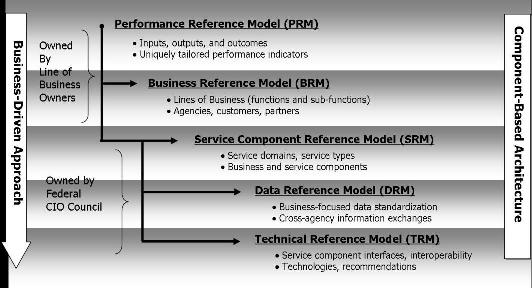Difference between revisions of "Use Cases"
m |
m |
||
| Line 1: | Line 1: | ||
| + | Back To: [[Main Page]] | ||
| + | ==Overview== | ||
| + | We have divided the use cases into several sections basically following the sections of the Federal Enterprise Architecture. | ||
| + | |||
| + | [[Image:FEA Reference Models.jpg|center|]] | ||
| + | <center>Figure 1. Federal Enterprise Architecture Reference Models</center> | ||
| + | <br> | ||
| + | Eventually, it might be useful to construct the ESIP exchange using a collection of interrelated "reference models" as employed by the US Government in the Federal Enterprise Architecture. | ||
| + | |||
| + | The most important aspects of our development strategy are shown on the left and right of Figure 1. Construction will be driven by the "business" of the Federation as described in our [[Federation Documents]]. The result will follow a component-based architecture. | ||
| + | |||
The Use Cases for the Earth Information Exchange are accessible from here. | The Use Cases for the Earth Information Exchange are accessible from here. | ||
| − | + | ==Diagrms== | |
:Mike Burnett presented the following diagrams of the various use cases: | :Mike Burnett presented the following diagrams of the various use cases: | ||
| Line 8: | Line 19: | ||
:Note: Download the Visio Viewer 2003 from Microsoft and view these diagrams in Explorer (if you don't have MS Visio). | :Note: Download the Visio Viewer 2003 from Microsoft and view these diagrams in Explorer (if you don't have MS Visio). | ||
| − | + | ==Applications Use Cases== | |
| + | |||
| + | It will be the scenarios that are created by each cluster that will drive the resource allocation. | ||
| + | |||
| + | ==Systems Use Cases== | ||
(currently only some of the use cases have been converted to Wiki format, the remainder are Word documents) | (currently only some of the use cases have been converted to Wiki format, the remainder are Word documents) | ||
Revision as of 05:42, July 22, 2006
Back To: Main Page
Overview
We have divided the use cases into several sections basically following the sections of the Federal Enterprise Architecture.
Eventually, it might be useful to construct the ESIP exchange using a collection of interrelated "reference models" as employed by the US Government in the Federal Enterprise Architecture.
The most important aspects of our development strategy are shown on the left and right of Figure 1. Construction will be driven by the "business" of the Federation as described in our Federation Documents. The result will follow a component-based architecture.
The Use Cases for the Earth Information Exchange are accessible from here.
Diagrms
- Mike Burnett presented the following diagrams of the various use cases:
- Note: Download the Visio Viewer 2003 from Microsoft and view these diagrams in Explorer (if you don't have MS Visio).
Applications Use Cases
It will be the scenarios that are created by each cluster that will drive the resource allocation.
Systems Use Cases
(currently only some of the use cases have been converted to Wiki format, the remainder are Word documents)
Use Case 02: Personalize User Experience
Use Case 04: Provider Management
Use Case 05: Manage Datasets/Collections Catalog
Use Case 08: Manage Groups/Communities
Use Case 09: Dataset Discovery
Use Case 10: Service Discovery
Use Case 11: Spatial Search for Data
Use Case 12: Temporal Search for Data [[1]]
Use Case 13: Parametric Search for Data
Use Case 14: Free Text Searching [[2]]
Use Case 15: Preview Dataset (metadata driven)
Use Case 16: Preview Granule (metadata driven)
Use Case 17: Online Access to Granules [[3]]
Use Case 18: Direct Access to Data [[4]]
Use Case 19: Present "Hot" Products [[5]]
Use Case 21: Collaborate with Other Users
Use Case 22: Subscribe to Data Availability [[6]]
Use Case 23: Notify Subscriber [[7]]
